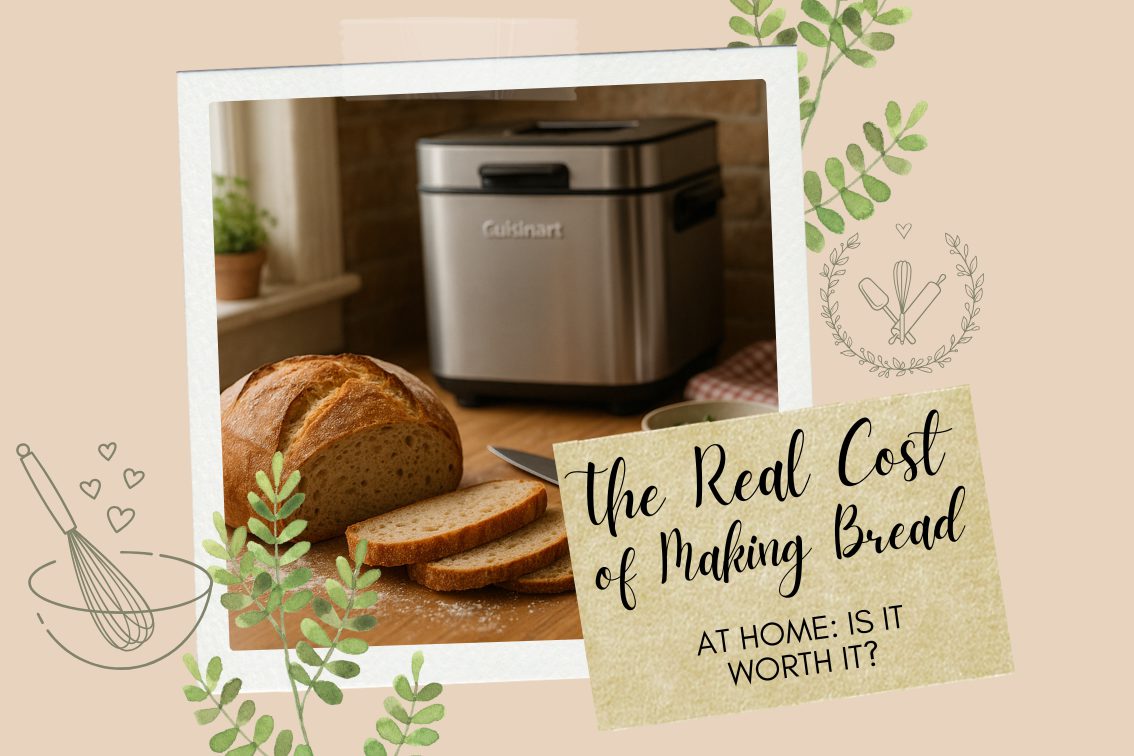*This post may contain affiliate links for which I earn commissions.*
I didn’t start making homemade bread just to save a few bucks—I started because I wanted to give my family something better. Healthier. The bread we get at the store today just isn’t the same as what we grew up with. I still remember when a loaf of bread would go moldy in a few days if you didn’t eat it fast enough. Now? It sits on the counter for two weeks and still looks the same. That can’t be healthy.
So I pulled out my bread machine and got to work.
Since then, I’ve learned a lot—not just about how to bake bread, but about what really goes into it, how much it costs, and whether making your own is actually cheaper than buying it at the store.
In this post, we’ll look at the cost of making bread at home, compare homemade bread vs store bought, and talk about more than just dollars—because for me, this journey has been about health, taste, and getting back to something real.
How Much Does It Really Cost to Make Bread at Home?
Let’s break it down. A basic homemade loaf doesn’t take much—just simple ingredients you probably already have in your pantry:
- Flour (white, wheat, or a blend)
- Yeast
- Salt
- Sugar or honey
- Oil or butter
- Water or milk
When you tally it up, most homemade loaves cost somewhere between $0.70 and $1.25 depending on the ingredients you use and where you buy them.
Here’s a quick example using basic ingredients:
| Ingredient | Cost per Loaf |
|---|---|
| 3 cups flour | $0.40 |
| Yeast (2¼ tsp) | $0.15 |
| Salt (1 tsp) | $0.01 |
| Sugar (1 tbsp) | $0.03 |
| Oil or butter | $0.10 |
| Water | Negligible |
| Total: | ~$0.70 |
Even if you splurge on higher-quality ingredients like organic flour or local honey, you’re still looking at a loaf for under $2—far cheaper than most store-bought bread, especially anything labeled “healthy” or “artisan.”
Homemade Bread vs Store Bought: What Are You Really Paying For?
On paper, store-bought bread might seem easier. Just toss it in the cart and go. But once you take a closer look—especially at the ingredients list—you start to realize there’s more going on than flour, yeast, and water.
Most commercial breads are made to sit on a shelf for weeks without changing. And to do that, they’re loaded with preservatives, conditioners, stabilizers, and sometimes even added sugars or corn syrup. That’s why bread from the store can stay “fresh” for two weeks without a hint of mold—something that used to happen in just a few days when we were kids.
With homemade bread, you know exactly what goes in—and just as importantly, what doesn’t.
Let’s compare the two:
| Feature | Homemade Bread | Store-Bought Bread |
|---|---|---|
| Cost per loaf | $0.70–$1.25 | $2.00–$6.00 |
| Shelf life | 3–5 days (no preservatives) | Up to 2+ weeks (with additives) |
| Ingredients | Real, simple, customizable | Often processed and artificial |
| Nutrition | Higher if using whole grains | Often stripped of fiber & nutrients |
| Taste | Fresh, warm, full of flavor | Bland or overly sweet |
Sure, a store-bought loaf might win for convenience, but it usually loses on taste, nutrition, and clean ingredients. And for me, that peace of mind—knowing what my family’s eating—is worth a lot more than a few minutes of saved time.
Plus, the taste? Let’s just say once you’ve had a slice of homemade bread still warm from the machine or oven, slathered in a little butter… there’s no going back.
What You’ll Need to Get Started (It’s Simpler Than You Think)
You don’t need a full-blown bakery setup to start making bread at home. In fact, you can get started with what’s already in most kitchens.
Here are two easy options:
1. Bread Machine (My Favorite)
This is my go-to. I just toss in the ingredients, press a button, and walk away. In about 3 hours, I’ve got a fresh loaf with barely any cleanup.
A decent bread machine costs around $80–$150, and they last for years. Mine’s been with me for a long time, and it’s paid for itself many times over. If you bake two loaves a week, it pays for itself in about 3–4 months.
Most machines also have dough settings, which means you can let the machine handle the mixing and rising, then shape the dough and bake it in the oven if you want a crustier loaf.
2. Oven Baking (Still Easy, Just a Bit More Hands-On)
If you love the feel of working with dough, oven baking is a great option. You’ll need:
- A large mixing bowl
- A sturdy spoon or stand mixer
- A loaf pan or baking stone
- A warm spot for dough to rise (the back of the stove works great!)
It takes more time and effort, but it’s also incredibly satisfying. There’s something special about kneading dough by hand—it slows you down in the best way.
Do You Have Time to Make Bread?
The honest answer? Yes—especially with a bread machine.
If you’re using a bread machine:
- Prep time: 5 minutes
- Baking time: Hands-off
That’s it. You can go about your day while your machine does the work. No babysitting. No complicated steps.
If you’re baking by hand:
- Prep + kneading: 15–20 minutes
- Rising/proofing: 1–2 hours (hands-off)
- Baking: 30–40 minutes
So yes, it takes a bit more planning if you’re doing it all manually, but it’s still completely doable—even on a busy schedule.
The Hidden Value of Homemade Bread
Sometimes we get so focused on dollars and cents that we forget the real reasons we do things.
For me, making bread at home isn’t just about the cost—it’s about feeding my family something I trust. It’s about slowing down for a few minutes to create something real, with my own hands, in my own kitchen.
Here are a few benefits that don’t show up on a receipt:
- Fewer chemicals and preservatives — just real, whole ingredients
- Better taste and texture — warm, soft, crusty, or fluffy—you decide
- That amazing smell — nothing makes a house feel like home faster
- Family tradition — passing down recipes, baking with grandkids, creating memories
- A sense of pride — it just feels good to say, “I made this”
There’s something incredibly rewarding about making something from scratch. And once you taste your own bread, fresh from the oven or machine… well, store-bought just won’t cut it anymore.
So, Is Making Bread at Home Really Worth It?
If you’ve been wondering whether it’s cheaper to bake your own bread, the short answer is: yes—absolutely. From a budget standpoint, the numbers speak for themselves. A homemade loaf can cost less than half of what you’d pay at the store, and that’s before you factor in the long-term savings of using a bread machine or buying ingredients in bulk.
But honestly? The savings are just the beginning.
When you compare homemade bread vs store bought, it’s not even close. With homemade bread, you get clean ingredients, unbeatable flavor, and full control over every loaf that comes out of your kitchen. No mystery additives. No soggy slices. No plastic packaging that never breaks down.
You’re not just making food—you’re making memories. You’re making something real.
So, Is Making Bread at Home Really Worth It?
If you’ve been wondering whether it’s cheaper to bake your own bread, the short answer is: yes—absolutely. From a budget standpoint, the numbers speak for themselves. A homemade loaf can cost less than half of what you’d pay at the store, and that’s before you factor in the long-term savings of using a bread machine or buying ingredients in bulk.
But honestly? The savings are just the beginning.
When you compare homemade bread vs store bought, it’s not even close. With homemade bread, you get clean ingredients, unbeatable flavor, and full control over every loaf that comes out of your kitchen. No mystery additives. No soggy slices. No plastic packaging that never breaks down.
You’re not just making food—you’re making memories. You’re making something real.

